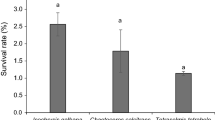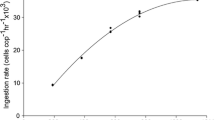Abstract
Artemia franciscana was grown on Isochrysis galbana Green (clone T. Iso) at saturated food concentrations (13 to 20 mg C l−1) for 11 d at 26 to 28 °C, and 34 ppt salinity. Three groups of brine shrimp were used in the feeding experiments: metanauplius III and IV (Group 1), post-metanauplius II and III (Group 2) and post-metanauplius VIII (Group 3), corresponding to 4-, 7- and 11-d-old animals, respectively. The ingestion rate, clearance rate and carbon balance were estimated for these stages at different concentrations of 14C-labeled I. galbana ranging from 0.05 to 30 mg C l−1. The handling time of algae was determined for all three groups. The ingestion rate (I, ng C ind−1 h−1) increased as a function of animal size and food concentration. In all three groups, the ingestion rate increased to a maximum level (I max) and remained constant at food concentrations ≥10 mg C l−1 (saturated food concentrations). The clearance rate (CR, μl ind−1 h−1) increased with increasing food concentration up to a maximum rate (CR max), after which it decreased for even higher food concentrations. The functional response of A. franciscana was most consistent with Holling's Type 3 functional response curve (sigmoidal model), which for the two oldest groups (Group 2 and 3) differed significantly from a Type 2 response (p < 0.05). The gut passage time for the three groups of A. franciscana, feeding on saturated food concentration (20 mg C l−1), varied between 24 and 29 min. As the nauplii developed to pre-adult stage the handling time of the algae increased as a function of animal size. The assimilation rate (ng C ind−1 h−1) in the youngest stages (Group 1 and 2) increased with increasing food concentrations, reaching a maximum level close to 10 mg C l−1. At higher food concentrations the assimilation rate decreased, and the proportions of defecated carbon increased, reaching 60 to 68% in the post-metanauplius stages (Group 3). The assimilation efficiency (%) was high at the lowest food concentrations in all three groups (89 to 64%). At higher concentrations, the assimilation efficiency decreased, reaching 56 to 38% at the highest concentrations.
Similar content being viewed by others
Author information
Authors and Affiliations
Additional information
Received: 2 February 2000 / Accepted: 25 March 2000
Rights and permissions
About this article
Cite this article
Evjemo, J., Vadstein, O. & Olsen, Y. Feeding and assimilation kinetics of Artemia franciscana fed Isochrysis galbana (clone T. Iso). Marine Biology 136, 1099–1109 (2000). https://doi.org/10.1007/s002270000306
Issue Date:
DOI: https://doi.org/10.1007/s002270000306




